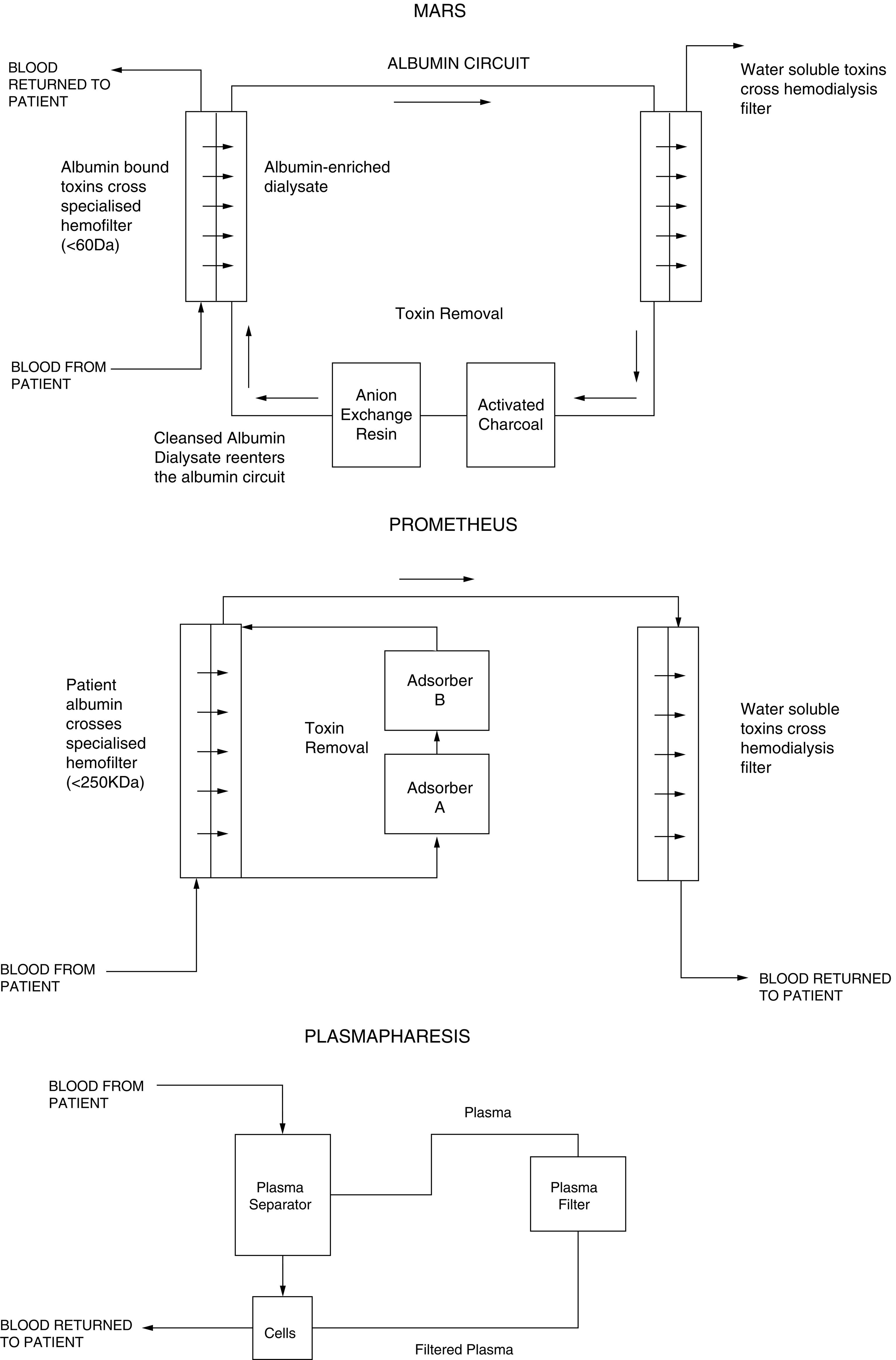Physical Address
304 North Cardinal St.
Dorchester Center, MA 02124
Currently, the standard medical treatment (SMT) for pediatric liver failure incorporates optimal supportive care with hemodynamic and respiratory support, infection control, and avoidance of gastrointestinal bleeding, aiming to bridge patients to recovery or to liver transplantation (LT). LT is the only definitive treatment for liver failure. Since the 1980s, emerging literature, within the adult setting, has studied the efficacy of extracorporeal liver support system (ELSS) in addition to SMT in liver failure as a means to improve biochemical and clinical parameters while a patient is being bridged to LT or recovery. ELSS can be broadly divided into (1) artificial liver support (ALS) and (2) bioartificial liver support (BALS). There are limited reports of ALS and no reports of BALS in pediatric literature. Biological support, such as hepatocyte transplantation, is a modality being studied as a bridge to LT and recovery in pediatric acute liver failure, although outside the remit of this chapter. There is much debate regarding the value of ELSS in liver failure, especially with improved median times for super-urgent LT and improved graft and survival outcomes post-LT. The routine use of ELSS has currently not been advocated in any pediatric guideline.
Literature on ELSS is mainly focused on adult liver failure, so caution needs to be taken when extrapolating evidence to pediatric liver failure because key differences exist. The definition of pediatric acute liver failure (PALF), unlike in adults, does not necessarily require the presence of hepatic encephalopathy (HE); the cause is often age-dependent, with metabolic causes more common in neonates and infants, and infectious, drug, or autoimmune-induced pathology in older children. This is in contrast to adult ALF, where paracetamol (PCM) toxicity is the most common cause in the developed world. Despite these differences, both pediatric and adult ALF have a high mortality rate, reaching 70% in children without transplantation, which necessitates super-urgent LT in 10% to 15% and 10% of pediatric and adult cases, respectively. Spontaneous recovery has been reported in one-third of pediatric and 40% of adult ALF cases.
ELSS has been most studied in acute-on-chronic liver failure (AoCLF), which is a well-described clinical entity in adults. It is defined as an acute deterioration of preexisting chronic liver disease, usually related to a precipitating event and associated with an increased 3-month mortality resulting from multisystem organ failure. It is associated with a mortality rate between 50% and 90%, and commonly follows an acute trigger to underlying alcoholic liver disease. However, in pediatrics, data on AoCLF are scarce, and no specific definition has been established. Documented experience for pediatric AoCLF is mainly from non-transplantation centers in India, where hepatotropic viruses and drugs are the most common triggers. Only a minority of patients are diagnosed with chronic liver disease before acute presentation—namely, autoimmune hepatitis and Wilson disease (WD). Mortality is lower in pediatric AoCLF compared with adults, albeit from limited data.
The ideal aim of an effective ELSS would be to bridge patients with ALF or AoCLF to recovery or LT, reducing wait-list mortality and improving clinical outcomes postrecovery or LT (e.g., neurological). However, short median waiting times for super-urgent LT in PALF and the inability to predict spontaneous recovery in PALF accurately lead to challenges when assessing the effectiveness of ELSS.
In liver failure, hemodialysis (HD) is highly effective for the removal of small and medium-sized water-soluble, unbound molecules (e.g., ammonia, urea) from the circulation across a semipermeable membrane into hypotonic dialysate fluid along their concentration gradients. However, larger albumin-bound molecules (e.g., bilirubin, bile acids), which accumulate and contribute to the progression of ALF and AoCLF, are not removed via HD. Subsequently, ALS should incorporate devices that can facilitate the removal of albumin-bound molecules to reduce liver injury and support bridging to recovery or LT.
Albumin dialysis devices constitute the main form of ALS. There are various adaptations of these devices, based on filtration and adsorption. The two commercially available devices ( Fig. 31.1 A, B ), which have been evaluated in the clinical setting, are MARS (Molecular Adsorbents Recirculating System; Baxter, Sweden) and Prometheus (FPSA-fractionated plasma separation and adsorption system; Fresenius Medical Care, Germany).

MARS consists of a primary circuit, whereby the patient’s blood passes through a specialized hemofilter with a size selection threshold (< 60 kDa) and a secondary circuit containing albumin-enriched dialysate, which passes the filter in a counterdirectional flow. Hemofiltration is required simultaneously to control the blood and dialysate circuits. This system enables albumin-bound toxins, but not albumin itself, to dissociate, passing through the membrane to attach to albumin in the secondary circuit. The secondary circuit then undergoes dialysis to remove the water-soluble toxins, and the albumin dialysate is regenerated by removing toxins via two adsorbers (activated charcoal and an anion resin), ready for use again. MARS has two filters available based on weight—above 25 kg, the adult filter (2.1 m; fill volume, 152 mL), and below 25 kg, the MARS minifilter (0.6 m; fill volume, 57 mL) suitable for pediatric use.
Prometheus consists of a primary circuit, whereby the patient’s blood passes through a large-pore (250–300 kDa), albumin-permeable membrane, enabling the patient’s albumin fraction to pass into a secondary circuit where albumin-bound toxins are removed via two adsorber columns. The cleansed dialysate can then reenter the primary circuit. Hence, unlike MARS, albumin is detoxified in vitro by temporarily separating albumin from blood. To date, Prometheus has been designed for the adult population only.
Single-pass albumin dialysis (SPAD) therapy, based on the concept of MARS, uses a standard hemofiltration filter to dialyze the patient’s blood against an albumin solution, removing small, protein-bound molecules. The albumin dialysate is discarded once used. This select plasma exchange therapy device is based on the Prometheus device, but instead the plasma is discarded and replaced with human albumin solution (HAS).
Become a Clinical Tree membership for Full access and enjoy Unlimited articles
If you are a member. Log in here